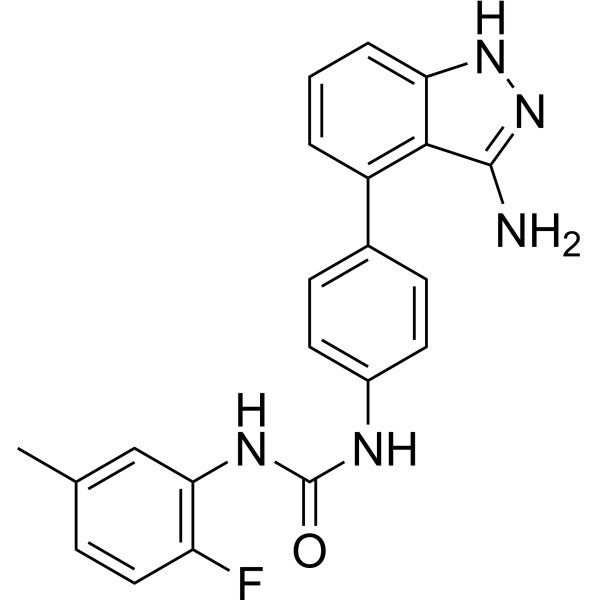Home
Products
Linifanib (ABT-869)



| Product Name | Linifanib (ABT-869) |
| Price: | Inquiry |
| Catalog No.: | CN00108 |
| CAS No.: | 796967-16-3 |
| Molecular Formula: | C21H18FN5O |
| Molecular Weight: | 375.41 g/mol |
| Purity: | >=98% |
| Type of Compound: | Alkaloids |
| Physical Desc.: | Powder |
| Source: | |
| Solvent: | Chloroform, Dichloromethane, Ethyl Acetate, DMSO, Acetone, etc. |
| SMILES: | O=C(Nc1cc(C)ccc1F)Nc1ccc(cc1)c1cccc2c1c(N)n[nH]2 |
| Contact us | |
|---|---|
| First Name: | |
| Last Name: | |
| E-mail: | |
| Question: | |
| Description | Linifanib (ABT-869) is a multi-targeted inhibitor of VEGF and PDGFR receptor family with IC50s of 3, 4, 66, 4 nM for KDR, Flt-1, PDGFRβ and FLT3, respectively. |
| Target | KDR:4 nM (IC50) PDGFRβ:66 nM (IC50) Flt-1:3 nM (IC50) FLT3:4 nM (IC50) |
| In Vitro | Linifanib exhibits IC50 values that range from 4 nM (KDR) to 190 nM (FLT4) for members of the VEGF and PDGF receptor families. Linifanib is also active against TIE2 and, to a lesser extent, RET, but is much less active (IC50>10 μM) against other nonrelated tyrosine kinases, such as steroid receptor coactivator and epidermal growth factor receptor. Phosphorylation of KDR induced by VEGF is inhibited by Linifanib with an IC50 of 4 nM in 3T3 murine fibroblasts engineered to express human KDR. A similar potency for inhibition of receptor autophosphorylation is seen with Linifanib when HUAECs are used as the target cell. Linifanib inhibits VEGF-stimulated phosphorylation of KDR completely at 10 nM and by 70% at 3 nM (IC50=2 nM)[1]. |
| In Vivo | Linifanib is effective orally in the mechanism-based murine models of VEGF-induced uterine edema (ED50=0.5 mg/kg) and corneal angiogenesis (>50% inhibition, 15 mg/kg). ABT-869 exhibits efficacy in human fibrosarcoma and breast, colon, and small cell lung carcinoma xenograft models (ED50=1.5-5 mg/kg, twice daily) and is also effective (>50% inhibition) in orthotopic breast and glioma models. Reduction in tumor size and tumor regression is observed in epidermoid carcinoma and leukemia xenograft models, respectively[1]. |
| Cell Assay | HUAEC are plated into 96-well plates at 2,500 per well and incubated with serum-free medium for 24 hours. Linifanib and VEGF(final, 10 ng/mL) are added and incubated for 72 hours in serum-free medium. For carcinoma cell lines, 2,500 per well are plated overnight in full growth medium. Linifanib is added to the cells in full growth medium and incubated for 72 hours. For leukemia cells, generally 50,000 per well are plated in full growth medium, drug added, and incubated for 72 hours. The effects on proliferation are determined by addition of Alamar Blue (final solution, 10%), incubation for 4 hours at 37jC in a CO2 incubator, and analysis in a fluorescence plate reader[1]. |
| Animal Admin | Mice: Tumor-bearing animals are divided into groups (n=10), and administration of vehicle (2% ethanol, 5% Tween 80, 20% PEG400, 73% saline) or inhibitor (Linifanib) at the indicted dose is initiated. Tumor growth in the flank is assessed by measuring tumor size with calipers and calculating size. Tumor volume for the orthotopic glioma model is determined using magnetic resonance imaging[1]. |
| Density | 1.4±0.1 g/cm3 |
| Boiling Point | 542.2±50.0 °C at 760 mmHg |
| Flash Point | 281.7±30.1 °C |
| Exact Mass | 375.149536 |
| PSA | 95.83000 |
| LogP | 4.34 |
| Vapour Pressure | 0.0±1.4 mmHg at 25°C |
| Storage condition | -20?C Freezer |